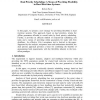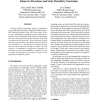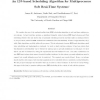111
click to vote
ICECCS
2009
IEEE
14 years 10 months ago
2009
IEEE
In hard real-time systems such as avionics, computer board level designs are typically customized to meet specific reliability and real time requirements. This paper focuses on co...
RTSS
1995
IEEE
15 years 3 months ago
1995
IEEE
In this paper, we present a new strategy for providing flexibility in hard real-time systems. This approach, based on dual priorities, retains the offline guarantees afforded to...
118
click to vote
ETFA
2006
IEEE
15 years 4 months ago
2006
IEEE
Classical off-line approaches based on preemption such as RM (Rate Monotonic), DM (Deadline Monotonic), EDF (Earliest Deadline First), LLF (Least Laxity First), etc, give schedula...
RTSS
1998
IEEE
15 years 4 months ago
1998
IEEE
: The Time-Triggered (TT) model of computation is a model for the representation and analysis of the design of large hard real-time systems. Central to this model is the concept of...
CODES
1998
IEEE
15 years 4 months ago
1998
IEEE
Timing analysis for checking satisfaction of constraints is a crucial problem in real-time system design. In some current approaches, the delay of software modules is precalculate...
114
click to vote
CODES
2000
IEEE
15 years 4 months ago
2000
IEEE
In this paper we present an approach to performance estimation for hard real-time systems. We consider architectures consisting of multiple processors. The scheduling policy is ba...
119
Voted
WORDS
2002
IEEE
15 years 5 months ago
2002
IEEE
Certainly, in hard real-time systems, it is reasonable to argue that no hard real-time threads should behave in an unpredictable way and that schedulability should be guaranteed b...
SPIN
2004
Springer
15 years 5 months ago
2004
Springer
Hard real-time systems need methods to determine upper bounds for their execution times, usually called worst-case execution
115
Voted
ECRTS
2005
IEEE
15 years 6 months ago
2005
IEEE
We consider the use of the earliest-deadline-first (EDF) scheduling algorithm in soft real-time multiprocessor systems. In hard real-time systems, a significant disparity exists...
97
Voted
ISSTA
2006
ACM
2006
ACM
Architecture-driven platform independent deterministic replay for distributed hard real-time systems
15 years 6 months ago
Distributed hard real-time systems have become a major component of many advanced technical products. Means to ensure their proper quality are thus of paramount importance. To ens...



